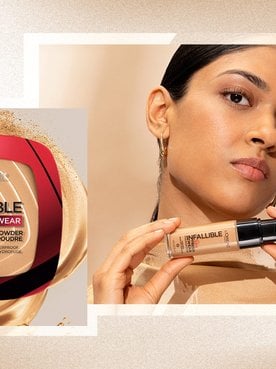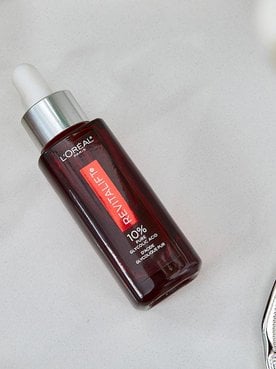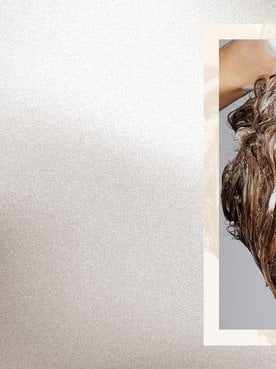By now, you know how important proper skin hydration is for maintaining a dewy, healthy-looking complexion. But what you may not realize is that moisturizing may not be quite enough to keep your skin sufficiently hydrated. Certain lifestyle habits, such as showering in hot water or spending too much time in the sun, can damage your skin and affect its ability to hang onto moisture. In order to keep your face hydrated throughout the day, you should avoid potentially drying stressors—and, of course, bolster your routine with plenty of hydrating skincare products. If you’re not sure where to start, that’s okay—you’ve got us. Keep reading to learn what hydrated skin is, why it’s important, and what can affect your skin’s hydration. Then, keep scrolling for tips on the best ways to add moisture to your face for a smooth, glowy complexion.
Why Is Skin Hydration Important?
Water is a key element of the skin’s natural moisture barrier, the body’s first line of defense against external stressors. Without sufficient hydration, the skin barrier can’t work as well as it should. Dehydration (in other words, a lack of water) can leave the skin rough and dry, increase sensitivity, and even make certain skin concerns—like fine lines, wrinkles, and sagging—more prominent.
What Is Hydrated Skin?
Put simply, hydrated skin is skin that has enough water to look and feel its best. Generally, if your skin is hydrated, it will appear firm, plump, and smooth, oftentimes with a bit of a natural-looking glow. It’ll also feel balanced. Tightness, dryness, and flakiness, meanwhile, are indications that your skin may need more moisture than you’re currently giving it. A lack of water can also lead to discomfort, especially if your skin stays dehydrated for an extended period of time.
What Can Cause Dehydrated Skin?
Certain habits, stressors, and practices can impact your skin’s ability to retain moisture, which can ultimately lead to dehydration. Some of the most common factors that can contribute to dehydrated skin include:
- Extreme weather conditions: Exposure to dry air—both cold and hot—can strip your skin of moisture and leave it feeling thirsty.
- Taking hot showers: Hot showers may be relaxing, but high water temperatures can dehydrate your skin. To help maintain skin hydration, it’s best to set the dial a bit lower—aim for lukewarm to warm (not scalding).
- Over-exfoliating: Regular exfoliation can help keep your skin soft and smooth, but overdoing it can have the opposite effect—and contribute to dehydration. Be sure to read the instructions on your chosen exfoliant for a clear idea of when (and how often) it should be used.
- Skipping moisturizer: This probably goes without saying, but if you want your skin to feel hydrated, moisturizing is a must. For most, twice daily is ideal (once in the morning and once at night).
What’s The Difference Between Dry Skin and Dehydrated Skin?
While dry skin and dehydrated skin often look quite similar, they differ in a few key ways. Firstly, dry skin is a skin type characterized by a lower-than-average production of oil. Those with dry skin typically experience some degree of dryness all year round, though a proper skincare routine can help keep the skin feeling balanced. Dryness can also develop over time, as sebum production typically declines with age.
Dehydration, meanwhile, is a skin concern characterized by a lack of water. It can affect anybody (including those with oily skin) and is often caused by exposure to external stressors or following an improper skincare routine. Unlike dry skin, it’s usually temporary—tweaking your habits and updating your skincare routine is often all it takes to get and maintain balanced, hydrated skin.
What’s The Difference Between Moisturizing and Hydrating Skincare?
Hydrating products and moisturizing products are both designed to help improve skin’s look and feel. However, they work in slightly different ways. Hydrating products are formulated to help boost your skin’s water content. They’re often lightweight and typically contain humectant ingredients such as hyaluronic acid or glycerin. Moisturizing products, on the other hand, create a protective barrier to help keep water in. They tend to be a bit richer in texture and may contain occlusive or emollient ingredients in their formulas.
If your skin is dehydrated, it’s a good idea to use both hydrating skincare products and moisturizing products in your routine. The former can help deliver much-needed moisture to your skin, while the latter can help ensure that moisture stays put.
How To Tell If Your Skin Is Dehydrated
If your skin is dull and tight, but you aren’t sure whether it’s due to dryness or dehydration, it may be a good idea to schedule a visit with your dermatologist. They can help determine whether your skin needs more water, oil, or both and recommend a routine suited to your skin type and unique concerns. You can also try an at-home test to gauge your overall skin hydration levels. One of the best tests is to pinch the skin on the middle knuckle of your pointer or middle finger. If the pinched skin stays in place for a moment or two before settling into its original position, chances are good that you’re not as hydrated as you should be.
What’s The Best Way To Hydrate Skin?
Maintaining a consistent skincare routine designed for your skin type and concerns is among the best ways to keep your skin hydrated. Ahead, learn how to hydrate your skin quickly to help restore a balanced, comfortable complexion.
Use a hydrating facial cleanser
You should always kick off your skincare routine by washing your face to remove dirt, oil, and other impurities. However, it’s important to choose the right cleanser for your needs and use it properly—anything too harsh could end up stripping your skin of moisture. To remove impurities without stripping your skin, we recommend using a gentle cream-based cleanser, like the L’Oréal Paris RevitaLift Radiant Smoothing Cream Cleanser. The mild formula gently exfoliates and removes impurities while helping to nourish the skin. You can use it twice daily (morning and night) to help promote a smoother, brighter-looking complexion.
Wash your face with lukewarm water
As we mentioned earlier, hot water is the enemy of hydrated skin. Whether bathing, showering, or simply washing your face at the sink, it’s a good idea to turn the water temperature down. It doesn’t need to be ice-cold—but it shouldn’t be steaming hot, either. If you can’t help but turn the temperatures up, be sure to keep your showers brief. The less time you spend submerging your skin in hot water, the better.
Use a hydrating facial serum
After washing your face, layer on a hydrating facial serum to help boost moisture. For long-lasting yet lightweight hydration, we love the L’Oréal Paris RevitaLift Derm Intensives 1.5% Pure Hyaluronic Acid Serum. The fast-absorbing formula instantly hydrates the skin, leaving it looking dewy and fresh. With consistent use, it also helps plump the skin to diminish the appearance of fine lines and wrinkles. If your skin is both dry and dehydrated, try the L’Oréal Paris Age Perfect Skin Care Cell Renewal Anti-Aging Midnight Serum. The luxe formula helps replenish the skin overnight when it’s most susceptible to repair. You’ll notice an immediate improvement in skin hydration, while continued use helps to promote a more radiant, youthful-looking complexion.

Shop the Products
Apply moisturizer to damp skin
The American Academy of Dermatology (AAD) recommends applying moisturizer while the skin is still damp to help trap in moisture and keep the skin hydrated. The formula you use should be dictated by your skin type: Rich creams tend to be best for those with drier skin types, while lightweight lotions are well-suited for those with oilier skin. If you’re not sure what skin type you have, opt for a formula suitable for all, like the L’Oréal Paris RevitaLift Triple Power Anti-Aging Moisturizer, which contains hyaluronic acid alongside vitamin C and pro-retinol. The L’Oréal Paris Collagen Filler Moisture Filler Facial Anti-Aging Moisturizer is another excellent pick for all skin types. It boasts a refreshing texture and delivers up to 48 hours of hydration without clogging pores or leaving the skin feeling greasy.
Layer on an eye serum
Whether you have dry skin or oily skin, the eye area is often one of the first places to show signs of dehydration. Just like serums with hyaluronic acid are great for the rest of the face, they can be highly beneficial for the eye area, too. For lasing hydration, try the L’Oréal Paris RevitaLift Derm Intensives 1.5% Hyaluronic Acid + 1% Caffeine Eye Serum. It contains both hyaluronic acid and caffeine and hydrates the under-eye area while helping to address dark circles and puffiness.

Update your routine seasonally
The lightweight moisturizer you use to hydrate your skin in the summer may not be as effective in the winter. Many find that their skin is more prone to dryness and dehydration in the winter (again, you can thank the low moisture levels in the air for that), and as such, requires more moisture than it does in the humid summer months. In cooler weather, a rich cream could help provide much-needed hydration to help keep your skin feeling balanced.
Wear sunscreen every day
Along with moisturizing consistently, remember to always apply sunscreen before heading outdoors: Sun exposure can damage the skin, leaving it dry, rough, and uneven. The United States Food and Drug Administration (FDA) recommends opting for a broad-spectrum formula with an SPF of at least 15. The L’Oréal Paris Bright Reveal Broad Spectrum SPF 50 Daily UV Lotion fits the bill—plus, the antioxidant-infused formula is ultra-light, non-greasy, and suitable for all skin types and tones.
Shop the Products
Use a hydrating facial spray
If you’re wondering how to keep your skin hydrated throughout the day, a facial spray can be a great addition to your routine. These convenient formulas are designed to be used on the go to help give your skin a boost of hydration anytime and anywhere (in most cases, you can even use them over your makeup). Stash one in your bag and give your face a light spritz anytime it starts to feel thirstier than you’d like.
Drink plenty of water
While chugging H2O won’t totally reverse dehydration, some research suggests that increasing your water intake could improve skin hydration levels, too. How much water you need per day depends on several factors, including the climate and your activity levels. Per the Mayo Clinic, the best rule of thumb is to drink up anytime you feel thirsty. Adding more water-rich foods (like watermelon and spinach) to your diet can help stave off dehydration, too.
Try water-based skincare products
Don’t assume that having oily skin means you can skimp on the moisturizer—all skin needs hydration, and that includes oily skin. If you tend to find most face creams feel too heavy on your face, reach for a water-based formula that can aid in hydration while remaining lightweight on the skin. Try the L’Oréal Paris RevitaLift Micro Hyaluronic Acid + Ceramides Line-Plumping Water Cream. It’s non-greasy, fast-absorbing, and suitable for all skin types (oily included). Apply it to your damp face morning and night to reveal brighter, healthier-looking skin over time.

Shop the Product
How To Hydrate Skin Overnight
Now that you’re well-versed in hydrating your skin at the start of (and throughout) the day, you need to be able to protect your complexion while you get your beauty rest, too. Let us note that you can’t hydrate your skin overnight as a quick fix—think of keeping your skin hydrated as a marathon, not a sprint. Try these four tips below to help you hydrate your skin while you sleep.
Invest in a humidifier
Using a humidifier is an especially smart idea in the winter, but know it can benefit your skin year-round if you live in a dry climate. Low moisture in the air can cause your skin to feel dry and exacerbate dehydration. Run a humidifier while you sleep to help add moisture back into the air and keep your skin feeling hydrated while you get your nightly eight(ish) hours.
Use an overnight face mask
Applying a face mask is a great way to add extra hydration to your skincare routine. While there are tons of face masks on the market that help address a number of skin concerns, those with dehydrated skin should look for options made with hydrating ingredients. The L’Oréal Paris RevitaLift Triple Power Anti-Aging Overnight Mask gets our vote—it contains hyaluronic acid, vitamin C, and pro-retinol and provides all-night, non-greasy hydration for all skin types. Slather it on before bed, and rinse your face in the morning for bright, radiant-looking skin.
Try slugging
Another great way to trap in moisture overnight is by slugging—in other words, applying a thick occlusive after smoothing on your moisturizer. The viral hack is a great way to help keep your skin from losing much-needed moisture while you sleep. The most popular vehicle for slugging is petroleum jelly, but this ointment-like balm can be a bit too rich for those with oily skin. Instead, try layering a richer night cream, like the L’Oréal Paris Age Perfect Skin Care Cell Renewal Midnight Cream, over your water-based moisturizer for added hydration.
Soothe dry lips
Dry, flaky lips are often uncomfortable, and they can also distract from an otherwise hydrated, healthy-looking complexion. To keep your pout looking soft and pillowy, gently exfoliate your lips before bed, then apply a moisturizing lip balm or lip oil on top. Try the L’Oréal Paris Plump Ambition Hyaluron Lip Oil—it contains hyaluronic acid and tripeptides and delivers up to 24 hours of hydration for smoother, plumper-looking lips.
Shop the Products
Next Up: How To Create a Targeted Skincare Routine for Dry Skin
Photo courtesy of L’Oréal Paris







